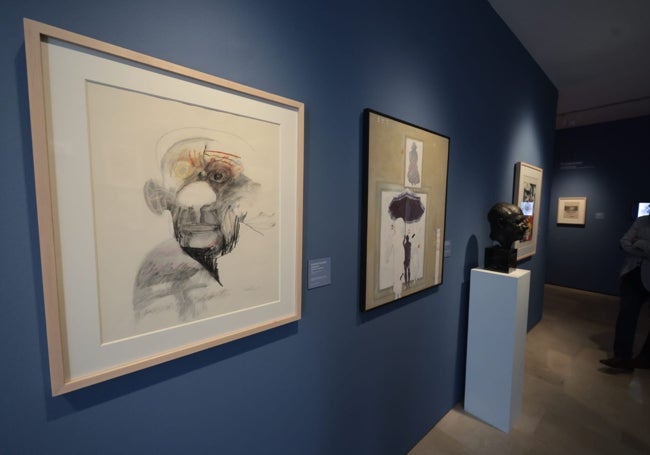Picasso the 'influencer' takes over the Casa Natal museum: from bad press to a K-pop song
A temporary exhibition reviews the impact of the genius as an icon in art, film, music and the press, from one of his first reports in 1937 to one of the last tweets about him
Malaga celebrated this 25 October some 142 years since Picasso's birth. And he is a character who has had everything said and written about him. Few painters have generated so much literature, graphic content, articles and artistic expression around their persona, even half a century after his death.
"Today he would be an 'influencer'," summarised Mario Virgilio Montañez, curator of the exhibition The Image of Picasso. The Casa Natal museum analyses the artist as an icon in an exhibition that reflects his vast media footprint without avoiding the 'black legend' (his bad reputation in the times of Franco) that surrounds him or his presence in popular and contemporary culture. He even has a reggaeton and a K-pop song named after him.
The first reference in the press dates back to 1937 in the French magazine Regards. 'Half an hour in Picasso's studio' is the title of the report on him while he was working on 'Guernica' and explains the motivation behind the work. The last thing there is about him is from a couple of weeks ago, a succession of tweets projected on a screen that mention him for good and also for bad.
"We wanted to be honest and reflect reality, we haven't avoided the controversy that surrounds Pablo Picasso, the Picassian black legend that began in 1957 with a critical view of his work and that continues to this day, associated with feminist activism."
In the 1950s, when he was already a recognised artist on a global scale, ABC headlined: "'Eight hundred square feet of nonsense is what Picasso has painted for Unesco', says the president of the Royal Academy."
Le Figaro wrote in 1955: "Picasso, an excellent fighter for peace but not a painter."
And in 1958 Noir et Blanc published "Picasso defeated by a four-year-old child", alluding to the tired expression that his paintings are "painted better by my child".
Françoise Gilot's book Life with Picasso (1964), which the artist himself tried to stop, gave rise to accusations of sexism and misogyny that have now been amplified on social media.
At the end of the 1980s, Arianna Huffington already stressed this idea in Picasso: Creator and Destroyer. Mario Virgilio Montañez categorically denies it. "Picasso was born in 1881. They try to judge him with 21st century parameters and that is trying to alter history," said the scholar and researcher of his work and his life. He was, he said, a child of his time. "And in spite of everything, no matter how much people bark, Picasso is still riding and still alive," he concluded.

Beyond his impact on the mass media, the figure of Picasso has inspired artists of all generations and fields. Equipo Crónica (a group of Spanish artists) reinterpreted 'Guernica', Robert Harvey recreated Robert Capa's famous photo of Picasso holding Françoise Gilot's umbrella, Ángel Idígoras dedicated a cartoon to him, as did Mingote a few days after his death.
Several of the 99 pieces that make up this exhibition are audiovisual, because Picasso was both the direct and indirect focus of the cameras. On the screens, you can see the documentary The Mystery of Picasso by Henri-Georges Clouzot (1956), which, according to the critics at the time, was received with little enthusiasm at Cannes.
There are also screenings from scenes from El Joven Picasso, starring Tony Zenet and directed by Juan Antonio Bardem, and Surviving Picasso, starring Anthony Hopkins, La Banda Picasso by Fernando Colomo and Genius: Picasso, in which Antonio Banderas plays the painter.
Picasso's influence also extends to the realms of music. The first composition dedicated to him was in 1948, a four-minute jazz improvisation - as avant-garde as the artist himself - by Coleman Hawkins.
But his name is also heard in urban music, in the reggaeton of Rio Roma & Nacho and Jahzel, and even in the K-pop song by the Korean group Shinee. David Bowie and Paul McCartney were also fans of the icon. As were flamenco greats such as Enrique Morente and Diego El Cigala. All the songs are available to listen to in the exhibition.
The exhibition, put together solely with funds from the Casa Natal, contains many other aspects that will surprise the public, who can visit until 28 April 2024. From the first plaque that was placed in his birthplace when it was still a poultry shop ("In this house Picasso was born on 25 October 1991. Remembering of the IV Congress of Intellectual Cooperation held in honour of Velázquez. February 1961") to the famous photo in the magazine Life, the front page of the SUR newspaper with the World Farewell to Picasso, rivalling the Holy Week opening in prominence, or the two sculptures by Yukimasa Ida, who has extended his stay in Malaga to be part of this project.
The exhibition, which has the support of La Caixa Foundation and CaixaBank, opens in the middle of October Picassiano as part of the events celebrating the 50th anniversary of the artist's death. It is, moreover, a complementary discourse to the one being exhibited these days at the Museo Picasso Málaga.
"For this Echo of Picasso to be produced and exhibited alongside the work of other artists, it was necessary to have built this icon of Picasso. He is one of the artists who, consciously or unconsciously, uses the evolution of the 'mass media' to his advantage to construct that image of what is today the great Picasso," concluded José María Luna, director of the public agency that manages the municipal museums.

